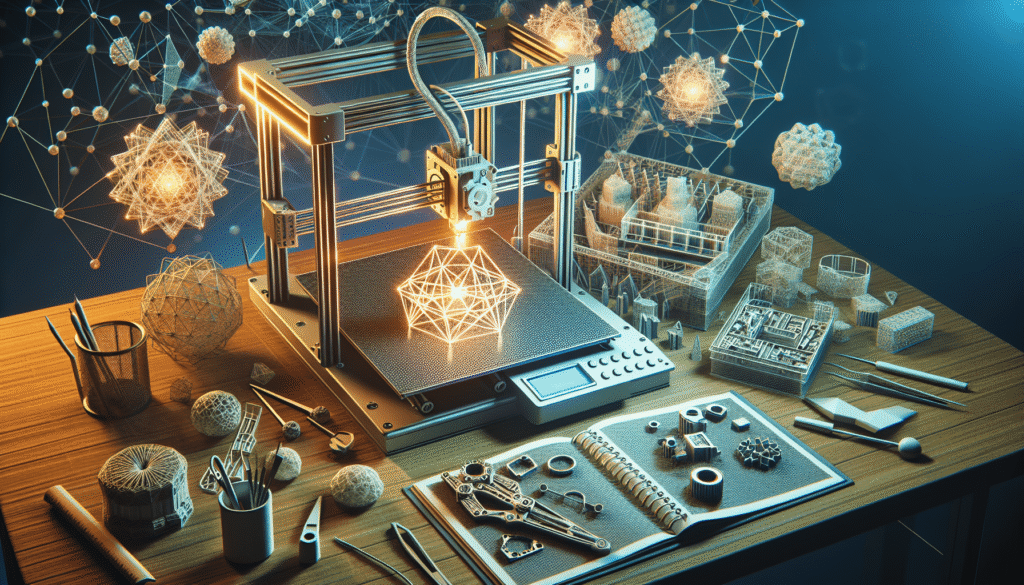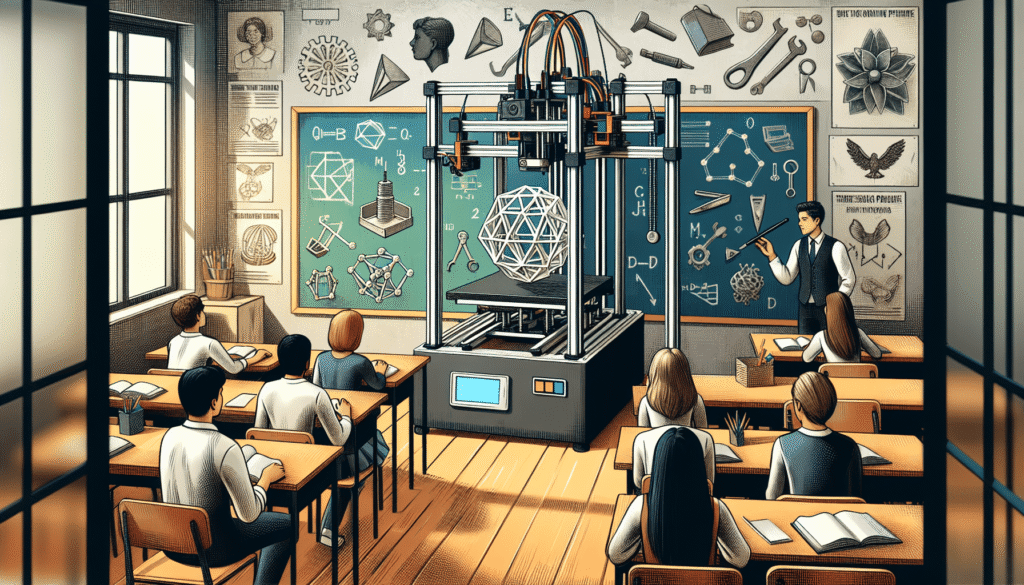Have you ever wondered how technology is reshaping the way we learn, particularly in the fields of Science, Technology, Engineering, and Mathematics (STEM)? It’s incredible how far we’ve come, especially with educational tools like 3D printing making their way into classrooms. This transformation is not just about having fun with gadgets; it’s about revolutionizing the STEM curriculum and enhancing the way students engage with complex concepts. Today, let’s explore how schools are integrating 3D printing into STEM learning, and the significant impact it is having on students and teachers alike.

Understanding 3D Printing in Education
What is 3D Printing?
3D printing, also known as additive manufacturing, is a process that creates a physical object from a digital design. It works by layering materials, such as plastic or metal, to build three-dimensional figures. Picture a desktop printer that doesn’t just print on paper but builds objects from the ground up by adding one layer of material after another. This technology has leaped from industrial and commercial use to educational settings, becoming an invaluable tool in the learning process.
How is 3D Printing Used in Schools?
Schools have embraced 3D printing to enrich their curriculum in various ways. Rather than relying solely on textbooks, students can now design and create models of molecules, replicas of historical artifacts, or even prototypes for engineering projects. By turning abstract concepts into tangible models, students gain a better grasp of the subject matter. Imagine being able to hold a model of a DNA strand or examine the architectural intricacies of the Parthenon—all crafted by your own hands!
The Impact on STEM Learning
Enhancing Comprehension Through Hands-On Learning
3D printing takes abstract or difficult concepts and breaks them down into interactive learning experiences. Instead of just reading about how gears work, students can print them out and see the mechanics in motion. Education experts often highlight the importance of kinesthetic learning—learning by doing—through which students can better understand and remember complex ideas.
For instance, in biology classes, 3D models of organs or molecular structures allow students to visualize the subject in a detailed and realistic manner. In engineering, creating prototypes motivates students to engage in trial and error, a critical part of learning that encourages innovation and problem-solving.
Encouraging Creativity and Innovation
3D printing is like a modern-day alchemy set for students. It inspires creativity by allowing them to bring their ideas to life. When students are tasked with a project that involves 3D printing, they are essentially entrusted with the full spectrum of the design process, from conception to execution. It encourages out-of-the-box thinking, where the only limit is, indeed, one’s imagination.
Students become inventors, designers, and architects, experimenting and iterating their designs. This process enhances not only technical skills but builds confidence and fosters an entrepreneurial mindset. They learn that failure is merely a step toward improvement, which is an invaluable lesson in both academic and life pursuits.
Facilitating Collaborative Learning
Introducing 3D printing into the classroom encourages collaboration among students. Projects often require teamwork, as multiple roles are necessary to see an idea from conception to creation. They might have to work with software developers to create designs, or team up with classmates to manage the sequence of printing and assembly. This teamwork simulates real-world scenarios, where collaboration across disciplines happens regularly.

Teachers’ Role in Integration
Training and Support
For 3D printing to be successfully integrated into schools, teachers need adequate training and resources. Unlike traditional teaching tools, using a 3D printer requires a certain degree of technical knowledge. Professional development workshops and ongoing support from technology specialists are crucial for educators to feel confident in using and teaching 3D printing technology.
Moreover, schools can facilitate peer learning among teachers by creating networks where experiences and strategies are shared. It’s a team effort, much like the collaborative learning process students experience.
Curriculum Development
As with any new technology, curriculum development is key to integrating 3D printing effectively. Teachers work alongside curriculum developers to incorporate 3D printing into lesson plans meaningfully. This could include developing specific projects that align with learning objectives or designing modules that focus on different aspects of 3D printing, such as design thinking or troubleshooting mechanical issues.
A successful integration requires adapting the curriculum to ensure that the technology enriches learning rather than becoming a distraction. Schools must carefully balance explorative play with structured learning outcomes.
Challenges and Considerations
Cost Implications
One of the primary challenges of integrating 3D printing in schools is the cost. Aside from the printers themselves, costs include materials, maintenance, and potential upgrades. Budget constraints can be a significant hurdle, especially for schools with limited funding.
However, various solutions can help mitigate these costs, such as forming partnerships with tech companies, applying for grants, or setting up community fundraisers. The investment might be steeper upfront, but the long-term educational benefits could well justify it.
Keeping Up with Rapid Technological Changes
Technology evolves quickly, and educational institutions often find themselves struggling to keep up. 3D printers today might be obsolete a few years down the line. Thus, adopting a flexible strategy that anticipates change and encourages adaptation is essential. Schools might need to designate a tech committee to monitor advancements and suggest upgrades or changes as needed.
Ensuring Access and Equity
It is vital that 3D printing technology and the opportunities it affords are accessible to all students. Schools must ensure equitable access across different demographics to prevent widening the gap between students who benefit from technological advances and those who do not.
Strategies include integrating 3D printing across various subjects so that all students, regardless of their academic inclinations, have exposure. Additionally, after-school clubs or programs focusing on 3D printing can provide extra support and access.
Future Prospects of 3D Printing in Education
Bridging the Gap Between Theory and Real-World Application
The potential for 3D printing in education is boundless. As the technology becomes more sophisticated, it can dramatically bridge the gap between theoretical knowledge and its real-world application. For instance, students might one day work on projects that solve actual community issues, utilizing 3D printing to prototype solutions that could be implemented in the real world.
Additionally, these experiences can ignite students’ interest in STEM careers, offering a taste of professional environments and problems they might encounter. It’s education with direct relevance and applicability, preparing students for future careers.
Fostering Interdisciplinary Learning
As 3D printing becomes increasingly integrated, its uses will likely transcend traditional subject boundaries. Students might work on projects that combine art, science, and technology, fostering an interdisciplinary approach to education. This kind of learning can be incredibly valuable, reflecting the multifaceted nature of real-world challenges that require collaborative, cross-disciplinary strategies.
Continuous Evolution of Educational Tools
3D printing in education will continue to evolve, offering new tools and techniques to educators and students. With advancements in related technologies like AI and machine learning, 3D printing could offer even more customized and efficient educational experiences.
Imagine a classroom where AI assists in optimizing 3D printed designs or offers immediate feedback on student projects. The possibilities are endless, and although we may not see AI-powered printing nationwide just yet, the horizon is gleaming with potential.
Conclusion
In integrating 3D printing into education, schools are not only transforming STEM learning but also reshaping the future landscape of education. This technology brings experiential learning to the forefront, enhances creativity, encourages collaboration, and prepares students for the realities of the future workplace.
Of course, challenges like cost and technological advancement remain, but with strategic planning and support, they are not insurmountable. The key is to view these challenges as opportunities for innovation. As 3D printing continues to evolve and its application in education expands, we stand on the cusp of an exciting frontier in learning that promises to unlock the potential of students everywhere.


